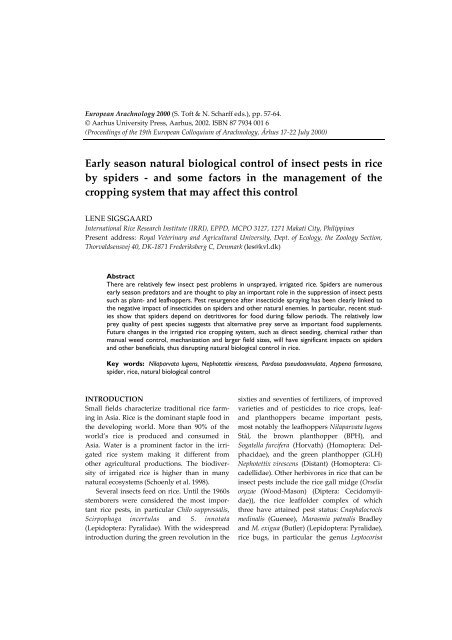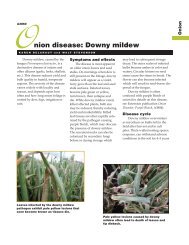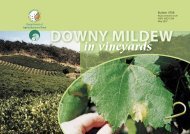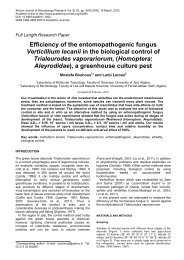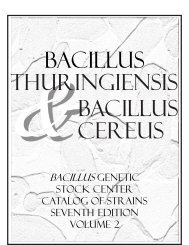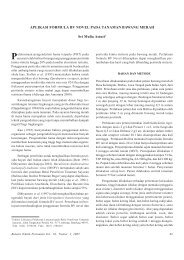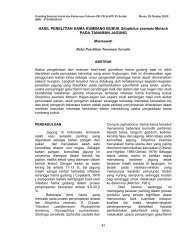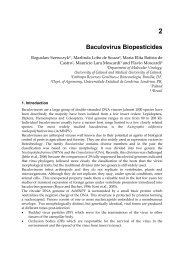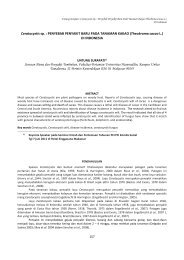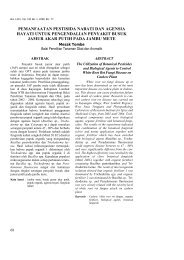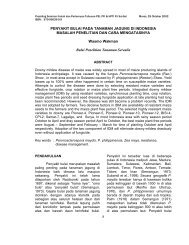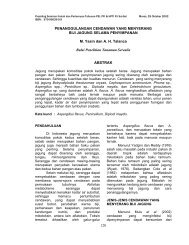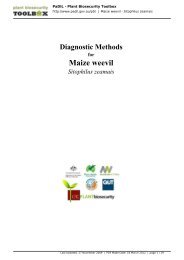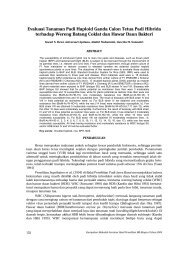Early season natural biological control of insect pests in rice by ...
Early season natural biological control of insect pests in rice by ...
Early season natural biological control of insect pests in rice by ...
Create successful ePaper yourself
Turn your PDF publications into a flip-book with our unique Google optimized e-Paper software.
57<br />
European Arachnology 2000 (S. T<strong>of</strong>t & N. Scharff eds.), pp. 57-64.<br />
© Aarhus University Press, Aarhus, 2002. ISBN 87 7934 001 6<br />
(Proceed<strong>in</strong>gs <strong>of</strong> the 19th European Colloquium <strong>of</strong> Arachnology, Århus 17-22 July 2000)<br />
<strong>Early</strong> <strong>season</strong> <strong>natural</strong> <strong>biological</strong> <strong>control</strong> <strong>of</strong> <strong><strong>in</strong>sect</strong> <strong>pests</strong> <strong>in</strong> <strong>rice</strong><br />
<strong>by</strong> spiders - and some factors <strong>in</strong> the management <strong>of</strong> the<br />
cropp<strong>in</strong>g system that may affect this <strong>control</strong><br />
LENE SIGSGAARD<br />
International Rice Research Institute (IRRI), EPPD, MCPO 3127, 1271 Makati City, Philipp<strong>in</strong>es<br />
Present address: Royal Veter<strong>in</strong>ary and Agricultural University, Dept. <strong>of</strong> Ecology, the Zoology Section,<br />
Thorvaldsensvej 40, DK-1871 Frederiksberg C, Denmark (les@kvl.dk)<br />
Abstract<br />
There are relatively few <strong><strong>in</strong>sect</strong> pest problems <strong>in</strong> unsprayed, irrigated <strong>rice</strong>. Spiders are numerous<br />
early <strong>season</strong> predators and are thought to play an important role <strong>in</strong> the suppression <strong>of</strong> <strong><strong>in</strong>sect</strong> <strong>pests</strong><br />
such as plant- and leafhoppers. Pest resurgence after <strong><strong>in</strong>sect</strong>icide spray<strong>in</strong>g has been clearly l<strong>in</strong>ked to<br />
the negative impact <strong>of</strong> <strong><strong>in</strong>sect</strong>icides on spiders and other <strong>natural</strong> enemies. In particular, recent studies<br />
show that spiders depend on detritivores for food dur<strong>in</strong>g fallow periods. The relatively low<br />
prey quality <strong>of</strong> pest species suggests that alternative prey serve as important food supplements.<br />
Future changes <strong>in</strong> the irrigated <strong>rice</strong> cropp<strong>in</strong>g system, such as direct seed<strong>in</strong>g, chemical rather than<br />
manual weed <strong>control</strong>, mechanization and larger field sizes, will have significant impacts on spiders<br />
and other beneficials, thus disrupt<strong>in</strong>g <strong>natural</strong> <strong>biological</strong> <strong>control</strong> <strong>in</strong> <strong>rice</strong>.<br />
Key words: Nilaparvata lugens, Nephotettix virescens, Pardosa pseudoannulata, Atypena formosana,<br />
spider, <strong>rice</strong>, <strong>natural</strong> <strong>biological</strong> <strong>control</strong><br />
INTRODUCTION<br />
Small fields characterize traditional <strong>rice</strong> farm<strong>in</strong>g<br />
<strong>in</strong> Asia. Rice is the dom<strong>in</strong>ant staple food <strong>in</strong><br />
the develop<strong>in</strong>g world. More than 90% <strong>of</strong> the<br />
world’s <strong>rice</strong> is produced and consumed <strong>in</strong><br />
Asia. Water is a prom<strong>in</strong>ent factor <strong>in</strong> the irrigated<br />
<strong>rice</strong> system mak<strong>in</strong>g it different from<br />
other agricultural productions. The biodiversity<br />
<strong>of</strong> irrigated <strong>rice</strong> is higher than <strong>in</strong> many<br />
<strong>natural</strong> ecosystems (Schoenly et al. 1998).<br />
Several <strong><strong>in</strong>sect</strong>s feed on <strong>rice</strong>. Until the 1960s<br />
stemborers were considered the most important<br />
<strong>rice</strong> <strong>pests</strong>, <strong>in</strong> particular Chilo suppressalis,<br />
Scirpophaga <strong>in</strong>certulas and S. <strong>in</strong>notata<br />
(Lepidoptera: Pyralidae). With the widespread<br />
<strong>in</strong>troduction dur<strong>in</strong>g the green revolution <strong>in</strong> the<br />
sixties and seventies <strong>of</strong> fertilizers, <strong>of</strong> improved<br />
varieties and <strong>of</strong> pesticides to <strong>rice</strong> crops, leafand<br />
planthoppers became important <strong>pests</strong>,<br />
most notably the leafhoppers Nilaparvata lugens<br />
Stål, the brown planthopper (BPH), and<br />
Sogatella furcifera (Horvath) (Homoptera: Delphacidae),<br />
and the green planthopper (GLH)<br />
Nephotettix virescens (Distant) (Homoptera: Cicadellidae).<br />
Other herbivores <strong>in</strong> <strong>rice</strong> that can be<br />
<strong><strong>in</strong>sect</strong> <strong>pests</strong> <strong>in</strong>clude the <strong>rice</strong> gall midge (Orselia<br />
oryzae (Wood-Mason) (Diptera: Cecidomyiidae)),<br />
the <strong>rice</strong> leaffolder complex <strong>of</strong> which<br />
three have atta<strong>in</strong>ed pest status: Cnaphalocrocis<br />
med<strong>in</strong>alis (Guenee), Marasmia patnalis Bradley<br />
and M. exigua (Butler) (Lepidoptera: Pyralidae),<br />
<strong>rice</strong> bugs, <strong>in</strong> particular the genus Leptocorisa
58<br />
European Arachnology 2000<br />
(Hemiptera: Coreidae), pentatomid bugs, <strong>rice</strong><br />
hispa (Dicladispa armigera (Oliver) (Coleoptera:<br />
Hispidae), <strong>rice</strong> thrips (Thysanoptera: Thripidae),<br />
<strong>rice</strong> caseworm (Nymphula depunctalis<br />
(Guenee) (Lepidoptera: Pyralidae) and whorl<br />
maggot flies (several species <strong>of</strong> the genus Hydrellia<br />
(Diptera: Ephydridae)) (see for example<br />
Pathak & Kahn 1994).<br />
However, unsprayed, irrigated <strong>rice</strong> fields<br />
have relatively few <strong><strong>in</strong>sect</strong> pest problems. This<br />
is largely attributed to <strong>natural</strong> <strong>biological</strong> <strong>control</strong>,<br />
which keep planthoppers, most notably<br />
BPH, and other potential <strong>pests</strong> <strong>in</strong> check<br />
(Kenmore et al. 1984; Way & Heong 1994).<br />
SPIDERS IN RICE<br />
Three guilds <strong>of</strong> spiders are found <strong>in</strong> <strong>rice</strong>: orbweav<strong>in</strong>g<br />
spiders, hunt<strong>in</strong>g spiders and spaceweb<br />
spiders. Orb-weavers <strong>in</strong>clude the families<br />
Araneidae, Tetragnathidae and Theridosomatidae.<br />
The most common orb-weaver genera are<br />
Tetragnatha, Araneus and Argiope. Lycosids<br />
dom<strong>in</strong>ate the guild <strong>of</strong> hunters, while the guild<br />
<strong>of</strong> space-web spiders conta<strong>in</strong> three families<br />
Theridiidae, L<strong>in</strong>yphiidae and Agelenidae<br />
(Barrion and Lits<strong>in</strong>ger 1995).<br />
Natural <strong>biological</strong> <strong>control</strong> <strong>in</strong> irrigated <strong>rice</strong> at<br />
the early crop stages can ma<strong>in</strong>ly be attributed<br />
to spiders. Orb-weav<strong>in</strong>g spiders are the most<br />
abundant spiders assessed across the cropp<strong>in</strong>g<br />
<strong>season</strong>, with Tetragnatha spp. be<strong>in</strong>g the s<strong>in</strong>gle<br />
most common genus <strong>in</strong> South East Asian countries,<br />
except the Philipp<strong>in</strong>es where Pardosa pseudoannulata<br />
is the more common species. Heong<br />
et al. (1992) found a relative abundance <strong>of</strong> P.<br />
pseudoannulata <strong>of</strong> 25 to 54% <strong>of</strong> all spiders at five<br />
<strong>rice</strong> sites <strong>in</strong> the Philipp<strong>in</strong>es across the <strong>season</strong>.<br />
Lowest abundance <strong>of</strong> A. formosana was found at<br />
the two sites at higher elevations <strong>of</strong> 800 and<br />
1500 m (7 and 9%), highest at the lower elevations<br />
(23, 35 and 40%). Three species <strong>of</strong> tetragnathids,<br />
Tetragnatha virescens Okuma, T. maxillosa<br />
Thorell, and T. javana (Thorell) together<br />
comprised 10 to 39% <strong>of</strong> the spiders <strong>in</strong> these<br />
sites. However, orb-weavers usually become<br />
abundant when <strong><strong>in</strong>sect</strong> damage has already occurred<br />
(Barrion and Lits<strong>in</strong>ger 1984).<br />
In the first 35 days after transplant<strong>in</strong>g the<br />
dom<strong>in</strong>ant predators <strong>in</strong> irrigated <strong>rice</strong> are the<br />
lycosid Pardosa pseudoannulata (Bösenberg &<br />
Strand) and the l<strong>in</strong>yphiid Atypena formosana<br />
(Oi) (Sigsgaard et al. 1999, the Philipp<strong>in</strong>es;<br />
Sahu et al. 1996, Northern Bihar, India). Both<br />
spiders are considered important predators <strong>of</strong><br />
BPH and Nephotettix virescens (Distant)<br />
(Hemiptera: Cicadellidae), the green leafhopper<br />
(GLH). P. pseudoannulata is perhaps the s<strong>in</strong>gle<br />
most important predator <strong>of</strong> BPH, and can<br />
effectively regulate the pest population <strong>of</strong> leafhoppers<br />
and planthoppers (Kiritani et al. 1972;<br />
Gavarra & Raros 1975; Kiritani & Kakiya 1975;<br />
Kenmore 1980; Kenmore et al. 1984; Shepard et<br />
al. 1987; Ooi & Shepard 1994). Both spiders occur<br />
throughout the year. P. pseudoannulata is<br />
most common among the tillers at the base <strong>of</strong><br />
the plants. It preys on a wide array <strong>of</strong> <strong><strong>in</strong>sect</strong><br />
<strong>pests</strong>, <strong>in</strong>clud<strong>in</strong>g leafhoppers and planthoppers,<br />
whorl maggot flies, leaffolders, caseworm and<br />
stem borers (Barrion & Lits<strong>in</strong>ger 1984; Shepard<br />
et al. 1987, Rubia et al. 1990). Field densities <strong>of</strong><br />
both spiders co-vary with hopper densities<br />
(Reddy & Heong 1991). References to the importance<br />
<strong>of</strong> the smaller and less conspicuous A.<br />
formosana have been few until recently<br />
(Shepard et al. 1987; Inthavong et al. 1996; Barrion<br />
1999; Sigsgaard & Villareal 1999). A. formosana<br />
adults and immatures prefer to live among<br />
the <strong>rice</strong> stem or at the base <strong>of</strong> <strong>rice</strong> hills. They<br />
have been observed to hunt for nymphs <strong>of</strong><br />
planthoppers and leafhoppers, Collembola,<br />
and small dipterans, such as whorl maggot flies<br />
(Barrion and Lits<strong>in</strong>ger 1984, Shepard et al. 1987,<br />
Sigsgaard and Villareal 1999a).<br />
Later <strong>in</strong> the cropp<strong>in</strong>g <strong>season</strong> predatory<br />
bugs become the most numerous predators.<br />
The most abundant <strong>of</strong> these are Microvelia douglasi<br />
atrol<strong>in</strong>eata Bergoth (Veliidae), Mesovelia vittigera<br />
(Horvath) (Mesoveliidae), and Cyrtorh<strong>in</strong>us<br />
lividipennis Reuter (Miridae) (Heong et<br />
al. 1991).<br />
PEST MANAGEMENT IN RICE<br />
Until the green revolution BPH was considered<br />
a m<strong>in</strong>or pest, but dur<strong>in</strong>g the seventies it be-
Sigsgaard: Spiders <strong>in</strong> <strong>rice</strong><br />
59<br />
came a major pest <strong>in</strong> <strong>rice</strong>. This demonstrated<br />
the effects <strong>of</strong> ‘turn<strong>in</strong>g <strong>of</strong>f’ the <strong>biological</strong> <strong>control</strong><br />
<strong>of</strong> this pest, which is normally <strong>control</strong>led at low<br />
levels <strong>by</strong> the many spiders and other <strong>natural</strong><br />
enemies (Matteson 2000). Kenmore et al. (1984)<br />
showed that BPH populations <strong>in</strong>creased drastically<br />
when spider and veliid predators were<br />
removed. When <strong><strong>in</strong>sect</strong>icide use was <strong>in</strong>tensified,<br />
<strong><strong>in</strong>sect</strong>icide resistant stra<strong>in</strong>s <strong>of</strong> <strong><strong>in</strong>sect</strong> <strong>pests</strong><br />
emerged. Rice varieties resistant to some <strong>pests</strong><br />
<strong>in</strong>clud<strong>in</strong>g BPH were developed, but plant<strong>in</strong>g<br />
over large areas created <strong>pests</strong>, most notably<br />
BPH, which could overcome the plant resistance<br />
(He<strong>in</strong>richs & Mochida, 1984). Subsequently<br />
new pest management strategies, Integrated<br />
Pest Management (IPM) were developed<br />
that emphasized host plant resistance,<br />
<strong>biological</strong> <strong>control</strong> and m<strong>in</strong>imal use <strong>of</strong> <strong><strong>in</strong>sect</strong>icides<br />
(Waage 1999).<br />
An <strong>in</strong>creas<strong>in</strong>g amount <strong>of</strong> research evidence<br />
from tropical irrigated <strong>rice</strong> areas shows that<br />
there is little or no crop loss <strong>in</strong> <strong><strong>in</strong>sect</strong>icide untreated<br />
fields (Kenmore 1991; Lits<strong>in</strong>ger 1991;<br />
Way & Heong 1994). This <strong>in</strong>cludes defoliators<br />
and stem borers that were recorded as important<br />
<strong>pests</strong> even before the green revolution.<br />
This <strong>in</strong>consistency may be expla<strong>in</strong>ed <strong>by</strong>: a) earlier<br />
estimates <strong>of</strong> yield loss were based more on<br />
damage than on actual yield, b) moderate resistance<br />
aga<strong>in</strong>st <strong><strong>in</strong>sect</strong> <strong>pests</strong> <strong>in</strong> many modern varieties,<br />
c) the ability <strong>of</strong> some modern varieties<br />
to compensate for damage, because they produce<br />
more tillers (Rubia et al. 1989), and d)<br />
better <strong>control</strong> <strong>of</strong> <strong><strong>in</strong>sect</strong> <strong>pests</strong> <strong>by</strong> <strong>natural</strong> enemies<br />
with less use <strong>of</strong> <strong><strong>in</strong>sect</strong>icides (Way & Heong<br />
1994).<br />
F<strong>in</strong>d<strong>in</strong>gs that moderately BPH-resistant and<br />
BPH-susceptible <strong>rice</strong>s grown <strong>by</strong> a large number<br />
<strong>of</strong> farmers have had low and stable BPH populations<br />
for several years suggest that the pest<br />
<strong>control</strong> strategy <strong>in</strong> <strong>rice</strong> should be revised to put<br />
higher priority on <strong>natural</strong> <strong>biological</strong> <strong>control</strong><br />
(Heong & Schoenly 1998).<br />
Apart from the fact that <strong><strong>in</strong>sect</strong>icide use is<br />
rarely necessary, it also poses a risk to farmer<br />
health and the environment (Heong et al. 1995).<br />
Cont<strong>in</strong>ued <strong><strong>in</strong>sect</strong>icide use stresses the need to<br />
bridge the gap between research and farmers.<br />
FAO (Food and Agriculture Organization <strong>of</strong><br />
the United Nations) has supported Farmers’<br />
Field Schools <strong>in</strong> many countries and provided<br />
farmers with a practical understand<strong>in</strong>g <strong>of</strong> <strong>in</strong>tegrated<br />
pest and nutrient management<br />
(Matteson 2000). The expectation is that the<br />
farmers who receive tra<strong>in</strong><strong>in</strong>g will pass their<br />
new knowledge on to other farmers. Another<br />
approach was developed <strong>by</strong> Heong et al.<br />
(1998). Here farmers were motivated to ‘test’ a<br />
simple rule <strong>of</strong> thumb (no spray necessary <strong>in</strong> the<br />
first 40 days after sow<strong>in</strong>g) <strong>by</strong> the use <strong>of</strong> communication<br />
media, <strong>in</strong>clud<strong>in</strong>g the radio. The<br />
practice <strong>of</strong> no early spray is now adopted <strong>by</strong><br />
many farmers <strong>in</strong> southern Vietnam, and recommended<br />
<strong>by</strong> the National Agricultural Research<br />
and Extension Agencies <strong>in</strong> Malaysia, the Philipp<strong>in</strong>es,<br />
and Thailand (K.L. Heong, pers. comm.).<br />
SPIDERS AND THEIR ROLE IN THE<br />
IRRIGATED RICE AGROECOSYSTEM<br />
Detritivores and organic material<br />
The population build-up <strong>of</strong> <strong>natural</strong> enemies is<br />
dependent on the availability <strong>of</strong> suitable host/<br />
prey. The abundant detritivores early <strong>in</strong> the<br />
<strong>season</strong> may be one key to the success <strong>of</strong> the<br />
current <strong>rice</strong> agroecosystem (Settle et al. 1996).<br />
Be<strong>in</strong>g polyphagous predators, spiders can prey<br />
on alternative prey such as Collembola dur<strong>in</strong>g<br />
fallow periods, here<strong>by</strong> ma<strong>in</strong>ta<strong>in</strong><strong>in</strong>g high population<br />
levels. (I here use the term alternative<br />
prey to describe all suitable prey other than the<br />
target species). The levels <strong>of</strong> these alternative<br />
prey <strong>in</strong> turn depend on decay<strong>in</strong>g organic material<br />
available <strong>in</strong> the field. Field and laboratory<br />
data from research at the International Rice<br />
Research Institute <strong>in</strong> the Philipp<strong>in</strong>es (IRRI) and<br />
elsewhere <strong>in</strong>dicate that spiders survive and<br />
build up their populations on alternative prey,<br />
such as Collembola and dipterans, before the<br />
crop is established and <strong>in</strong> the first weeks after<br />
crop establishment (Guo et al. 1995; Settle et al.<br />
1996).<br />
Settle et al. (1996) were able to <strong>in</strong>crease the<br />
number <strong>of</strong> detritus feeders, such as collembola,<br />
and <strong>of</strong> plankton feeders <strong>by</strong> add<strong>in</strong>g organic ma-
60<br />
European Arachnology 2000<br />
terial to the <strong>rice</strong> field <strong>in</strong> the treated plots. Most<br />
<strong>in</strong>terest<strong>in</strong>gly the number <strong>of</strong> spiders <strong>in</strong>creased<br />
<strong>in</strong> the same plots. Plankton feeders <strong>in</strong> that<br />
study <strong>in</strong>cluded mosquito larvae and chironomid<br />
midge larvae, <strong>of</strong> which many species<br />
also feed on detritus (Settle et al. 1996). In a<br />
study at IRRI, the addition <strong>of</strong> <strong>rice</strong> straw bundles<br />
<strong>in</strong> the <strong>rice</strong> field after harvest <strong>in</strong>creased the<br />
number <strong>of</strong> A. formosana and P. pseudoannulata<br />
as well as plant- and leafhoppers (Shepard et<br />
al. 1989). Though the study <strong>by</strong> Shepard et al.<br />
(1989) did not report effects on Collembola<br />
density, high Collembola density can be observed<br />
<strong>in</strong> recently cut straw, so probably the<br />
beneficial effect was also due to an <strong>in</strong>crease <strong>in</strong><br />
Collembola. In upland, <strong>rice</strong> weed residues<br />
placed with<strong>in</strong> the <strong>rice</strong> fields can significantly<br />
<strong>in</strong>crease spider densities (Afun et al. 1999).<br />
Apart from provid<strong>in</strong>g refuges for predators<br />
and <strong>in</strong>creas<strong>in</strong>g the density <strong>of</strong> alternative prey,<br />
organic material will also <strong>in</strong>fluence plant nutrition,<br />
which <strong>in</strong> turn can <strong>in</strong>fluence herbivores<br />
feed<strong>in</strong>g on the crop. One can speculate that this<br />
<strong>in</strong> turn could <strong>in</strong>directly affect predators.<br />
Dietary value <strong>of</strong> <strong><strong>in</strong>sect</strong> <strong>pests</strong> and alternative<br />
prey<br />
Spiders may not be as polyphagous as earlier<br />
thought (T<strong>of</strong>t 1999). The dietary value <strong>of</strong> alternative<br />
prey would determ<strong>in</strong>e its role <strong>in</strong> ma<strong>in</strong>ta<strong>in</strong><strong>in</strong>g<br />
a high population <strong>of</strong> spiders early <strong>in</strong><br />
the cropp<strong>in</strong>g <strong>season</strong>. The dietary value <strong>of</strong> alternative<br />
prey <strong>in</strong> terms <strong>of</strong> immature survival and<br />
development and adult fecundity can be high,<br />
as found <strong>in</strong> a recent study at IRRI (Sigsgaard et<br />
al., 2001a). In contrast BPH and GLH are <strong>of</strong> low<br />
quality to A. formosana. Similar results were<br />
obta<strong>in</strong>ed for P. pseudoannulata with fecundity as<br />
a fitness parameter, but BPH was <strong>of</strong> <strong>in</strong>termediate<br />
to high quality for this predator (Sigsgaard<br />
et al. 2001b). Earlier, T<strong>of</strong>t (see for example T<strong>of</strong>t<br />
1995, 1996, 1999), found aphids to be a generally<br />
poor quality prey for l<strong>in</strong>yphiid and lycosid<br />
spiders. These f<strong>in</strong>d<strong>in</strong>gs extend this to other Homopterans,<br />
like the BPH and GLH. Results suggest<br />
that spiders would perform less well <strong>in</strong> an<br />
agroecosystem with little alternative prey.<br />
Intraguild predation has been documented<br />
<strong>by</strong> Heong et al. (1990), <strong>in</strong> cage experiments<br />
with P. pseudoannulata prey<strong>in</strong>g upon BPH and<br />
the mirid bug C. lividipennis, and <strong>by</strong> Fagan et al.<br />
(1998), with P. pseudoannulata prey<strong>in</strong>g upon<br />
hoppers and mesoveliid bugs. Predator preyswitch<strong>in</strong>g,<br />
<strong>in</strong>traguild predation and cannibalism<br />
are thought to help predator survival when<br />
prey is scarce (Way & Heong 1994).<br />
Bunds and surround<strong>in</strong>g habitats<br />
Between the irrigated <strong>rice</strong> fields there are usually<br />
bunds, which may be narrow and low and<br />
reconstructed <strong>of</strong>ten with low and poor vegetation,<br />
or which may be wider and higher and<br />
with more permanent vegetation. Some bunds<br />
are used for grow<strong>in</strong>g vegetables or fruits. The<br />
bunds surround<strong>in</strong>g the <strong>rice</strong> fields provide refugia<br />
for predators dur<strong>in</strong>g fallow periods as well<br />
as dur<strong>in</strong>g farm operations. Bunds may be particularly<br />
important as a source <strong>of</strong> colonization<br />
<strong>by</strong> ground dispers<strong>in</strong>g predators, such as large<br />
P. pseudoannulata spiderl<strong>in</strong>gs and adults, and<br />
may be less important for l<strong>in</strong>yphiids as A. formosana,<br />
which colonizes the <strong>rice</strong> field <strong>by</strong> balloon<strong>in</strong>g.<br />
Prelim<strong>in</strong>ary results from a study <strong>of</strong> the<br />
directional movement <strong>of</strong> predators between the<br />
<strong>rice</strong> field and the bund show that P. pseudoannulata<br />
is an early colonizer <strong>of</strong> newly established<br />
<strong>rice</strong>, with the highest relative abundance <strong>of</strong> P.<br />
pseudoannulata <strong>in</strong> the bund, stress<strong>in</strong>g the importance<br />
<strong>of</strong> this habitat (Sigsgaard et al. 1999). The<br />
same study showed that three or four weeks<br />
after transplant<strong>in</strong>g <strong>of</strong> <strong>rice</strong> the directional movement<br />
changed and the early planted field may<br />
have become a source <strong>of</strong> P. pseudoannulata to<br />
later planted fields. Even with<strong>in</strong> the soil cracks<br />
<strong>of</strong> the fallow <strong>rice</strong> field some spiders like P.<br />
pseudoannulata are commonly found (Arida and<br />
Heong 1994). The management <strong>of</strong> bunds can<br />
also affect spiders. Graz<strong>in</strong>g <strong>of</strong> bunds reduced<br />
the density <strong>of</strong> web-build<strong>in</strong>g spiders as well as<br />
<strong>of</strong> two hunt<strong>in</strong>g spider families, Lycosidae and<br />
Oxyopidae, probably due to loss <strong>of</strong> webb<strong>in</strong>g<br />
sites for the web-build<strong>in</strong>g spiders and hunt<strong>in</strong>g<br />
grounds for the hunt<strong>in</strong>g spiders (Barrion 1999).<br />
Rice fields are usually <strong>in</strong>term<strong>in</strong>gled with other
Sigsgaard: Spiders <strong>in</strong> <strong>rice</strong><br />
61<br />
crops and habitats such as coconut or banana,<br />
and houses, gardens, fallow fields and forests,<br />
creat<strong>in</strong>g a varied landscape mosaic. Rice is<br />
<strong>of</strong>ten grown <strong>in</strong> rotation with vegetables such as<br />
onions, or with legumes.<br />
Surround<strong>in</strong>g habitats may also serve as a<br />
source <strong>of</strong> spiders for the <strong>rice</strong> field. Barrion<br />
(1999) found, that the most abundant species <strong>in</strong><br />
some non-<strong>rice</strong> habitats (irrigation canal, setaside<br />
<strong>rice</strong> field, edge <strong>of</strong> bund, a common roadside<br />
habitat (the grass Saccharum spontaneum<br />
L.), coconut, banana, and coconut-banana<br />
mixed) were Theridion sp. (family Theridiidae),<br />
P. pseudoannulata and A. formosana. Two key<br />
spider species <strong>in</strong> <strong>rice</strong>, A. formosana and P. pseudoannulata<br />
are thus utiliz<strong>in</strong>g non-<strong>rice</strong> habitats.<br />
Of these habitats the bunds held the highest<br />
densities <strong>of</strong> A. formosana followed <strong>by</strong> the uncropped<br />
<strong>rice</strong> field, while P. pseudoannulata was<br />
almost equally abundant <strong>in</strong> all habitats except<br />
relatively low densities <strong>in</strong> the roadside habitat<br />
and banana plantation.<br />
THE RICE CROPPING SYSTEM IS FACING<br />
NEW CHANGES<br />
Resource conserv<strong>in</strong>g strategies such as the use<br />
<strong>of</strong> compost and the <strong>in</strong>tegration <strong>of</strong> fish and duck<br />
production with irrigated <strong>rice</strong>, practices that<br />
contribute to the <strong>control</strong> <strong>of</strong> weeds and <strong><strong>in</strong>sect</strong><br />
<strong>pests</strong> (Zhang 1992), are now be<strong>in</strong>g actively promoted<br />
<strong>in</strong> some countries such as Malaysia<br />
(Ibrahim 1999). These practices decreased substantially<br />
with the <strong>in</strong>troduction <strong>of</strong> pesticides<br />
and other partially or fully <strong>in</strong>compatible technologies.<br />
Today, the irrigated <strong>rice</strong> cropp<strong>in</strong>g system is<br />
fac<strong>in</strong>g changes, which may have equally strong<br />
effects on the characteristics <strong>of</strong> the system as<br />
the green revolution had, and may <strong>in</strong> turn affect<br />
the <strong>natural</strong> <strong>biological</strong> <strong>control</strong> <strong>of</strong> <strong><strong>in</strong>sect</strong> <strong>pests</strong><br />
<strong>in</strong> <strong>rice</strong>. With the rapid growth <strong>of</strong> cities there is<br />
less available water and labour for <strong>rice</strong> farm<strong>in</strong>g.<br />
It is foreseen that production will change<br />
towards more direct seed<strong>in</strong>g and less transplant<strong>in</strong>g,<br />
and towards other potentially water<br />
and labour sav<strong>in</strong>g methods, such as mechanization,<br />
larger fields and more synchronous<br />
cropp<strong>in</strong>g (IRRI 2000). In pen<strong>in</strong>sular Malaysia<br />
direct seed<strong>in</strong>g has now become the predom<strong>in</strong>ant<br />
method <strong>of</strong> crop establishment (Normiyah<br />
& Chang 1997). Larger fields and more synchronous<br />
plant<strong>in</strong>g may delay colonization <strong>by</strong><br />
predators, also reduc<strong>in</strong>g the benefit ga<strong>in</strong>ed<br />
from the abundant early <strong>season</strong> alternative<br />
prey. A delay <strong>in</strong> colonization <strong>by</strong> predators <strong>in</strong><br />
large monocultures <strong>of</strong> <strong>rice</strong> has been shown <strong>by</strong><br />
Settle et al. (1996) <strong>in</strong> Indonesia. Cont<strong>in</strong>uous<br />
flood<strong>in</strong>g has been found to be associated with<br />
higher spider numbers (Lam et al. 1997), suggest<strong>in</strong>g<br />
a possible lower density <strong>of</strong> spiders with<br />
less available water. The growth <strong>of</strong> areas under<br />
directly-seeded <strong>rice</strong>, as well as the <strong>in</strong>creas<strong>in</strong>g<br />
cost <strong>of</strong> hand weed<strong>in</strong>g, causes the use <strong>of</strong> herbicides<br />
to rise. Genetically modified <strong>rice</strong> may also<br />
affect the cropp<strong>in</strong>g system <strong>in</strong> ways not yet fully<br />
anticipated. For example, we do not know the<br />
consequences <strong>of</strong> creat<strong>in</strong>g a field with no lepidopterans,<br />
as may be the case <strong>in</strong> <strong>rice</strong> genetically<br />
modified to conta<strong>in</strong> the Bacillus thur<strong>in</strong>giensis<br />
tox<strong>in</strong>.<br />
Understand<strong>in</strong>g <strong>of</strong> the biology <strong>of</strong> <strong><strong>in</strong>sect</strong><br />
<strong>pests</strong>, their <strong>natural</strong> enemies and the factors <strong>in</strong><br />
the management <strong>of</strong> the cropp<strong>in</strong>g system, which<br />
may affect this <strong>control</strong>, can be an important<br />
tool <strong>in</strong> ma<strong>in</strong>ta<strong>in</strong><strong>in</strong>g the desirable traits <strong>of</strong> the<br />
current irrigated <strong>rice</strong> ecosystem, as the <strong>rice</strong><br />
cropp<strong>in</strong>g system changes.<br />
ACKNOWLEDGEMENTS<br />
Thanks to K.L. Heong, K.G. Schoenly, A.<br />
Barrion, S. T<strong>of</strong>t and M. Cohen for valuable discussions.<br />
Thanks to K.L. Heong, S. T<strong>of</strong>t and<br />
two anonymous referees for comment<strong>in</strong>g on an<br />
earlier draft <strong>of</strong> this paper.<br />
REFERENCES<br />
Afun, J.V.K., Johnson, D.E., & Russell-Smith, A.<br />
1999. The effects <strong>of</strong> weed residue management<br />
on <strong>pests</strong>, pest damage, predators and<br />
crop yield <strong>in</strong> upland <strong>rice</strong> <strong>in</strong> Cote d'Ivoire. Biological<br />
Agriculture & Horticulture 17 (1), 47-58.<br />
Arida, G.S. & Heong, K.L. 1994. Sampl<strong>in</strong>g spiders<br />
dur<strong>in</strong>g the <strong>rice</strong> fallow period. International<br />
Rice Research Notes 19 (1), 20.
62<br />
European Arachnology 2000<br />
Barrion, A. & Lits<strong>in</strong>ger, J. 1984. The spider<br />
fauna <strong>of</strong> Philipp<strong>in</strong>e <strong>rice</strong> agroecosystems. II.<br />
Wetland. Philipp<strong>in</strong>e Entomologist 6, 11-37.<br />
Barrion, A. & Lits<strong>in</strong>ger, J. 1995. Riceland spiders<br />
<strong>of</strong> South and Southeast Asia. CAB International/International<br />
Rice Research Institute.<br />
University Press, Cambridge.<br />
Barrion, A. 1999. Ecology <strong>of</strong> spiders <strong>in</strong> selected<br />
non-<strong>rice</strong> habitats and irrigated <strong>rice</strong> fields <strong>in</strong><br />
two southern Tagalog prov<strong>in</strong>ces <strong>in</strong> the Philipp<strong>in</strong>es.<br />
Ph.D. Thesis. University <strong>of</strong> the<br />
Philipp<strong>in</strong>es at Los Banos.<br />
Fagan, W.F., Hakim, A.L., Ariawan, H. & Yuliyant<strong>in</strong><strong>in</strong>gsih,<br />
S. 1998. Interactions between<br />
<strong>biological</strong> <strong>control</strong> efforts and <strong><strong>in</strong>sect</strong>icide<br />
applications <strong>in</strong> tropical <strong>rice</strong> agroecosystems:<br />
the potential role <strong>of</strong> <strong>in</strong>traguild predation.<br />
Biological Control 13 (2), 121-126.<br />
Gavarra M. & Raros R.S., 1975. Studies on the<br />
biology <strong>of</strong> the predatory wolf spider, Lycosa<br />
pseudoannulata Boesenberg & Strand. Philipp<strong>in</strong>e<br />
Entomologist, 2 (6), 427-444.<br />
Guo, Y.J., Wang, N.Y., Jiang, J.W., Chen, J.W. &<br />
Tang, J. 1995. Ecological significance <strong>of</strong> neutral<br />
<strong><strong>in</strong>sect</strong>s as a nutrient bridge for predators<br />
<strong>in</strong> irrigated <strong>rice</strong> arthropod communities.<br />
Ch<strong>in</strong>ese Journal <strong>of</strong> Biological Control 11,<br />
5-9.<br />
He<strong>in</strong>richs, E.A. & Mochida, O. 1984. From<br />
secondary to major pest status: the case <strong>of</strong><br />
the <strong><strong>in</strong>sect</strong>icide <strong>in</strong>duced <strong>rice</strong> brown<br />
planthopper, Nilaparvata lugens, resurgence.<br />
Protection Ecology 7, 201-218.<br />
Heong, K., Bleih, S. & Rubia, E. 1990. Prey preference<br />
<strong>of</strong> the wolf spider, Pardosa pseudoannulata<br />
(Boesenberg et Strand). Researches on<br />
Population Ecology 32, 179-186.<br />
Heong, K.L., Aqu<strong>in</strong>o, G.B. & Barrion, A.T. 1991.<br />
Arthropod Community Structures <strong>of</strong> Rice<br />
Ecosystems <strong>in</strong> the Philipp<strong>in</strong>es. Bullet<strong>in</strong> <strong>of</strong><br />
Entomological Research 81 (4), 407-416.<br />
Heong, K., Aqu<strong>in</strong>o, G. & Barrion, A. 1992.<br />
Population dynamics <strong>of</strong> plant- and leafhoppers<br />
and their <strong>natural</strong> enemies <strong>in</strong> <strong>rice</strong> ecosystems<br />
<strong>in</strong> the Philipp<strong>in</strong>es. Crop Protection 4,<br />
371-379.<br />
Heong, K.L., Escalada, M.M. & Lazaro, A.A.<br />
1995. Misuse <strong>of</strong> pesticides among <strong>rice</strong> farmers<br />
<strong>in</strong> Leyte, Philipp<strong>in</strong>es. In: Impact <strong>of</strong> pesticides<br />
and farmer health and the <strong>rice</strong> environment<br />
(P.L. P<strong>in</strong>gali & P.A. Roger eds.), pp.<br />
97-108. IRRI, Los Banos, Laguna.<br />
Heong, K.L., Escalada, M.M., Huanh, N.H. &<br />
Mai, V. 1998. Use <strong>of</strong> communication media<br />
<strong>in</strong> chang<strong>in</strong>g <strong>rice</strong> farmers’ pest management<br />
<strong>in</strong> the Mekong Delta, Vietnam. Crop Protection<br />
17 (5), 413-425.<br />
Heong, K.L. & Schoenly, K.G. 1998. Impact <strong>of</strong><br />
<strong><strong>in</strong>sect</strong>icides on herbivore-<strong>natural</strong> enemy<br />
communities <strong>in</strong> tropical <strong>rice</strong> ecosystems. In:<br />
Ecotoxicology: pesticides and beneficial organisms,<br />
(P.T. Haskell & P.McEwen eds.), pp.<br />
381-403. Kluwer, Dordrecht, Netherlands.<br />
Ibrahim, R. 1999. Malaysia. Far East Agriculture<br />
May/June 1999, 16-17.<br />
Inthavong, S., Inthavong, K., Sengsaulivong,<br />
V., Schiller, J.M., Rapusas, H.R., Barrion, A.<br />
T. & Heong, K.L. 1996. Arthropod biodiversity<br />
<strong>in</strong> Lao irrigated <strong>rice</strong> ecosystem. In: Proceed<strong>in</strong>gs<br />
<strong>of</strong> the Rice Integrated Pest Management<br />
(IPM) Conference: Integrat<strong>in</strong>g science and<br />
people <strong>in</strong> Rice Pest Management, 18-21 November<br />
1996, Kuala Lumpur, Malaysia (A.<br />
A. Hamid et al., eds.), pp. 69-85. Malaysian<br />
Agricultural Research and Development<br />
Institute, Kuala Lumpur, Malaysia.<br />
IRRI, 2000. IRRI Annual Report 1999-2000. The<br />
Rewards <strong>of</strong> Rice Research. International Rice<br />
Research Institute, Los Banos, Philipp<strong>in</strong>es.<br />
Kenmore, P.E. 1980. Ecology and outbreaks <strong>of</strong> a<br />
tropical <strong><strong>in</strong>sect</strong> pest <strong>of</strong> the green revolution,<br />
the <strong>rice</strong> brown planthopper, Nilaparvata<br />
lugens (Stål), PhD dissertation. University <strong>of</strong><br />
California, Berkeley, USA.<br />
Kenmore, P.E., Car<strong>in</strong>o, F., Perez, C., Dyck, V. &<br />
Gutierrez, A. 1984. Population regulation <strong>of</strong><br />
the <strong>rice</strong> brown planthopper (Nilaparvata<br />
lugens Stal) with<strong>in</strong> <strong>rice</strong> fields <strong>in</strong> the Philipp<strong>in</strong>es.<br />
Journal <strong>of</strong> Plant Protection <strong>in</strong> the Tropics<br />
1, 1-37.<br />
Kenmore, P.E., 1991. Indonesia’s <strong>in</strong>tegrated pest<br />
management – a model for Asia. Food and Agriculture<br />
Organisation, Manila, Philipp<strong>in</strong>es.<br />
Kiritani, K. & Kakiya N. (1975) An analysis <strong>of</strong>
Sigsgaard: Spiders <strong>in</strong> <strong>rice</strong><br />
63<br />
the predator-prey system <strong>in</strong> the paddy field.<br />
Research <strong>in</strong> Population Ecology 17 (1), 29-38.<br />
Kiritani, K., Kawahara, S., Sasaba, T. & Nakasuji,<br />
F. (1972) Quantitative evaluation <strong>of</strong><br />
predation <strong>by</strong> spiders on the green leafhopper<br />
Nephotettix c<strong>in</strong>cticeps Uhler, <strong>by</strong> sightcount<br />
method. Research <strong>in</strong> Population Ecology<br />
13, 187-200.<br />
Lam, P.V., Huong, T.H. & Lan, T.T. 1997. A<br />
study on spider fauna <strong>of</strong> <strong>rice</strong> fields. Nong<br />
Nghiep Cong Ngiep Thuc Pham 3, 107-109.<br />
Lits<strong>in</strong>ger, J.A. 1991. Crop loss assessment <strong>in</strong><br />
<strong>rice</strong>. In: Rice <strong><strong>in</strong>sect</strong>s: management strategies (E.<br />
A. He<strong>in</strong>richs & T.A. Miller eds.), pp. 1-65.<br />
Spr<strong>in</strong>ger Verlag, New York.<br />
Matteson, P.C. 2000. Insect pest management <strong>in</strong><br />
tropical Asian irrigated <strong>rice</strong>. Annual Review<br />
<strong>of</strong> Entomology 45, 549–574.<br />
Normiyah, R. & Chang, P.M. 1997. Pest management<br />
practices <strong>of</strong> <strong>rice</strong> farmers <strong>in</strong> the<br />
Muda and Kemubu irrigation schemes <strong>in</strong><br />
pen<strong>in</strong>sular Malaysia. In: Pest management <strong>of</strong><br />
<strong>rice</strong> farmers <strong>in</strong> Asia, (K.L. Heong & M.M.<br />
Escalada eds.), pp. 115-127. IRRI, Los Banos,<br />
Philipp<strong>in</strong>es.<br />
Ooi, P.A.C. & Shepard, B.M. 1994. Predators<br />
and parasitoids <strong>of</strong> <strong>rice</strong> <strong><strong>in</strong>sect</strong> <strong>pests</strong>. In: Biology<br />
and management <strong>of</strong> <strong>rice</strong> <strong><strong>in</strong>sect</strong>s, (E.A.<br />
He<strong>in</strong>richs ed.), pp. 585-612. Wiley Eastern<br />
Limited [For] IRRI, New Delhi.<br />
Pathak, M.D. & Kahn, Z.R. 1994. Insect <strong>pests</strong> <strong>of</strong><br />
<strong>rice</strong>. International Rice Research Institute,<br />
Manila, Philipp<strong>in</strong>es.<br />
Reddy, P.S. & Heong, K.L. 1991. Co-variation<br />
between <strong><strong>in</strong>sect</strong>s <strong>in</strong> a <strong>rice</strong>field and important<br />
spider species. International Rice Research<br />
Notes 16 (5), 24.<br />
Rubia, E.G., Shepard, B.M., Yamba, E.B., Ingram,<br />
K.T., Arida, G.S., Penn<strong>in</strong>g de Vries, F.<br />
1989. Stem borer damage and gra<strong>in</strong> yield <strong>of</strong><br />
flooded <strong>rice</strong>. Journal <strong>of</strong> Plant Protection <strong>in</strong> the<br />
Tropics 6, 205-211.<br />
Rubia, E., Almazan, L., & Heong, K. 1990. Predation<br />
<strong>of</strong> yellow stem borer (YSB) <strong>by</strong> wolf<br />
spider. International Rice Research Newsletter<br />
15, 22.<br />
Sahu, S., S<strong>in</strong>gh, R. & Kumar, P. 1996. Host preference<br />
and feed<strong>in</strong>g potential <strong>of</strong> spiders predaceous<br />
<strong>in</strong> <strong><strong>in</strong>sect</strong> <strong>pests</strong> <strong>of</strong> <strong>rice</strong>. Journal <strong>of</strong> Entomological<br />
Research 20 (2), 145-150.<br />
Schoenly, K.G., Justo, H.D., Barrion, A.T., Harris,<br />
M. & Bottrell, D.G. 1998. Analysis <strong>of</strong><br />
<strong>in</strong>vertebrate biodiversity <strong>in</strong> a Philipp<strong>in</strong>e<br />
farmer's irrigated <strong>rice</strong> field. Environmental<br />
Entomology 27 (5): 1125-1136.<br />
Settle, W.H., Ariawan, H., Astuti, E., Cahyana,<br />
W., Hakim, A.L., H<strong>in</strong>dayana, D., Lestari, A.<br />
S. & Pajarn<strong>in</strong>gsih 1996. Manag<strong>in</strong>g tropical<br />
<strong>rice</strong> <strong>pests</strong> through conservation <strong>of</strong> generalist<br />
<strong>natural</strong> enemies and alternative prey.<br />
Ecology 77 (7), 1975-1988.<br />
Shepard, B.M., Barrion, A.T., & Lits<strong>in</strong>ger, J.A.<br />
1987. Friends <strong>of</strong> the <strong>rice</strong> farmer. Helpful <strong><strong>in</strong>sect</strong>s,<br />
spiders and pathogens. International Rice Research<br />
Institute, Manila, Philipp<strong>in</strong>es.<br />
Shepard, B.M., Rapusas, H.R., & Estano, D.B.<br />
1989. Us<strong>in</strong>g <strong>rice</strong> straw bundles to conserve<br />
beneficial arthropod communities <strong>in</strong> the<br />
<strong>rice</strong>field. International Rice Research Notes 14,<br />
30-31.<br />
Sigsgaard, L. & Villareal, S. 1999. Predation<br />
rates <strong>of</strong> Atypena formosana (Araneae: L<strong>in</strong>yphiidae)<br />
on brown planthopper, and green<br />
leafhopper. International Rice Research Notes<br />
24 (3), 18.<br />
Sigsgaard, L., Villareal, S., Gapud, V., & Rajotte,<br />
E. 1999. Directional movement <strong>of</strong><br />
predators between the irrigated <strong>rice</strong> field<br />
and its surround<strong>in</strong>gs. In Biological <strong>control</strong> <strong>in</strong><br />
the Tropics. Towards efficient biodiversity and<br />
bioresource management for effective <strong>biological</strong><br />
<strong>control</strong>. Proceed<strong>in</strong>gs <strong>of</strong> the Symposium on Biological<br />
Control <strong>in</strong> the Tropics (L.W. Hong, S.S.<br />
Sastroutomo, I.G. Caunter, J. Ali, L.K.<br />
Yeang, S. Vijaysegaran & Y.H. Sen eds.), pp.<br />
43-47. The National Council for Biological<br />
Control (NCBC)/CAB International, South<br />
East Asian Regional Centre, Malaysia.<br />
Sigsgaard, L., T<strong>of</strong>t, S. & Villareal, S. 2001a. Dietdependent<br />
survival, development and fecundity<br />
<strong>of</strong> the spider Atypena formosana (Oi)<br />
(Araneae: L<strong>in</strong>yphiidae) – Implications for<br />
<strong>biological</strong> <strong>control</strong> <strong>in</strong> <strong>rice</strong>. Bio<strong>control</strong> Science<br />
and Technology 11, 233-244.
64<br />
European Arachnology 2000<br />
Sigsgaard, L., T<strong>of</strong>t, S. & Villareal, S. 2001b.<br />
Diet-dependent fecundity <strong>of</strong> the spiders<br />
Atypena formosana and Pardosa pseudoannulata,<br />
predators <strong>in</strong> irrigated <strong>rice</strong>. Agricultural<br />
and Forest Entomology 3, 285-295.<br />
T<strong>of</strong>t, S. 1995. Value <strong>of</strong> the aphid Rhopalosiphum<br />
padi as food for cereal spiders. Journal <strong>of</strong> Applied<br />
Ecology 32, 552-560.<br />
T<strong>of</strong>t, S. 1996. Indicators <strong>of</strong> prey quality for arthropod<br />
predators. In: Arthropod <strong>natural</strong> enemies<br />
<strong>in</strong> arable land. II. Survival, reproduction<br />
and enhancement (C.J.H. Booij & L.J.M.F. den<br />
Nijs eds.), pp. 107-116. Aarhus University<br />
Press, Aarhus.<br />
T<strong>of</strong>t, S. 1999. Prey choice and spider fitness.<br />
Journal <strong>of</strong> Arachnology 27, 301-307.<br />
Waage, J. 1999. Beyond the realm <strong>of</strong> conventional<br />
<strong>biological</strong> <strong>control</strong>: harness<strong>in</strong>g bioresources<br />
and develop<strong>in</strong>g <strong>biological</strong>ly-based<br />
technologies for susta<strong>in</strong>able pest management.<br />
In: Biological <strong>control</strong> <strong>in</strong> the Tropics. Towards<br />
efficient biodiversity and bioresource<br />
management for effective <strong>biological</strong> <strong>control</strong>. Proceed<strong>in</strong>gs<br />
<strong>of</strong> the Symposium on Biological Control<br />
<strong>in</strong> the Tropics (L.W. Hong, S.S. Sastroutomo,<br />
I.G. Caunter, J. Ali, L.K. Yeang, S.<br />
Vijaysegaran & Y.H. Sen eds.), pp. 5-17. The<br />
National Council for Biological Control<br />
(NCBC)/CAB International, South East<br />
Asian Regional Centre, Malaysia.<br />
Way, M.J. & Heong, K.L. 1994. The role <strong>of</strong> biodiversity<br />
<strong>in</strong> the dynamics and management<br />
<strong>of</strong> <strong><strong>in</strong>sect</strong> <strong>pests</strong> <strong>of</strong> tropical irrigated <strong>rice</strong>: A<br />
review. Bullet<strong>in</strong> <strong>of</strong> Entomological Research 84,<br />
567-587.<br />
Zhang, Z.Q. 1992. The Use <strong>of</strong> Beneficial Birds<br />
for Biological Pest Control <strong>in</strong> Ch<strong>in</strong>a. Bio<strong>control</strong><br />
News and Information 13 (1): 11-16.


